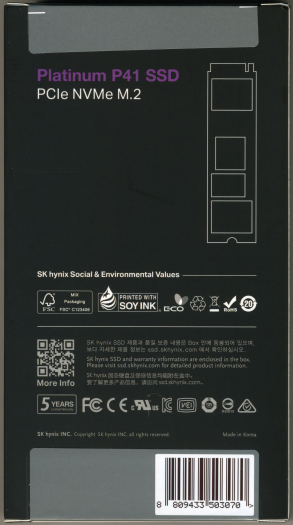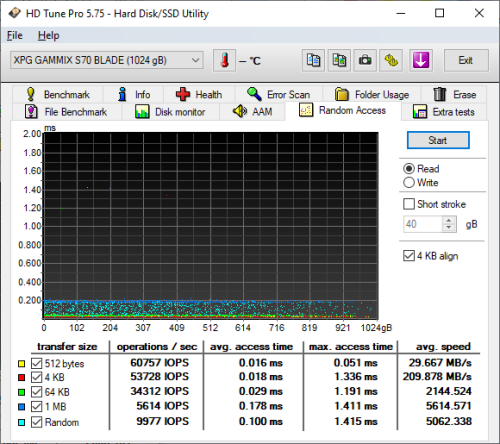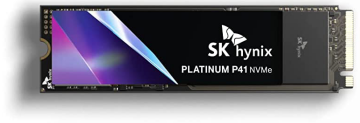

Model: SK hynix Platinum P41 2TB PCIe 4.0 M.2 Solid State Drive
Manufacturer: SK hynix
Provided By: SK hynix
As one of the biggest names in the semiconductor market, SK hynix doesn't need much of an introduction. Founded in 1983 as Hyundai Electronic Industrial Co., Ltd., the company quickly made its mark by producing Korea’s first 16Kb SRAM. Since then, SK hynix has continued to lead the industry with smaller, faster and lower power semiconductors. Today, they are the world's second-largest memory chipmaker as well as the third-largest semiconductor company. Their memory, NAND flash and CMOS image sensors are found in products from some of the biggest names in the computer industry including Apple, ASUS, Dell and HP.
With its background in NAND flash, it should come as no surprise that SK hynix is a major player in the SSD industry. In addition to supplying client and enterprise drives to PC OEMs, the company has begun a push into the U.S. retail market. Building on the success of its Gold P31 SSD, SK hynix recently launched its first PCIe 4.0 SSD, the Platinum P41. Aimed at gamers and content creators, this M.2 form factor drive is powered by SK hynix's own "Aries" controller and is available with up to 2TB of their 176-layer 3D TLC NAND flash. The Platinum P41 also features the company's HYPERWRITE cache technology and is equipped with an ultra-fast PCIe Gen4 x4 NVMe 1.4 interface.
The Platinum P41 is available in 500GB, 1TB and 2TB capacities. For this review, SK hynix sent us the 2TB version of the drive which is capable of delivering up to 7,000 MB/s sequential read and 6,500 MB/s sequential write speeds as well as up to 1,400K random read and 1,300K random write IOPS.
| SK hynix Platinum P41 2TB PCIe 4.0 M.2 Solid State Drive | |||||||||||||||||||||||||||||||||||
General Specifications
Performance
Reliability
Power Consumption
Dimensions and Weight
Other Features
|
Needless to say, this is only a taste of what the Platinum P41 has to offer. To give you an idea of what to expect, we'll take a closer look at SK hynix's new PCIe 4.0 SSD and then see how well it performs. Does the Platinum P41 have what it takes? Can it deliver the value and performance we've come to expect from SK hynix? Keep reading as we find out.
The Platinum P41 comes in a simple, yet attractive, black box with what appears to be a large, purple crystal on the front. Unfortunately, besides the capacity, there isn't a lot of information regarding the drive's specifications or features. If you want detailed product information, you will need to visit SK hynix's website.

Like most manufacturers, SK hynix doesn't include a lot of extras with the Platinum P41. Aside from the SSD, the only other things in the box were a couple of small, fold out guides containing warranty information as well as some brief installation instructions.
Physical Features:
The Platinum P41 uses the 2280 form factor for M.2 (NGFF) SSDs. It measures 22 x 80 x 2.23 mm and tips the scales at 7g. The drive also has an "M key" edge connector which provides PCIe SSDs with up to 4x lanes of bandwidth.

The Platinum P41 is the first drive to utilize SK hynix's "Aries" ACNS075 controller. Not much is known about this controller aside from that it has eight channels and has support for NVMe version 1.4.

One of the few complaints people had about the 500GB and 1TB versions of the Gold P31 was that the PCB was green in color. As with the 2TB version of the Gold P31, the Platinum P41 has a stealthy black PCB.

For the 2TB version of the Platinum P41, SK hynix has opted to use its own 176-layer 3D TLC NAND flash. If you'd remove the sticker, you'd see that there are two 1TB NAND flash packages on the top of the PCB. The drive also has a single 2GB LPDDR4 DRAM chip that is used for caching.
The test system used in this review is equipped with an AMD Ryzen 5 3700x CPU, MSI B550 GAMING PLUS motherboard, 16GB (8GB x 2) of Crucial Ballistix 3200 MHz DDR4 memory, Crucial P5 1TB SSD and a GIGABYTE GeForce GTX 1060 WINDFORCE OC 6G graphics card. For the operating system, I used the latest version of Windows 10 Pro.
To test the performance of SK hynix's Platinum P41 SSD, I ran a series of benchmarks using CrystalDiskMark, HD Tach RW, ATTO Disk Benchmark, AS SSD, HD Tune Pro, Anvil's Storage Utilities, Iometer and PCMark. For comparison, I've also included test results from the Silicon Power XS70, WD_BLACK SN770, ADATA XPG ATOM 50, ADATA XPG GAMMIX S70 Blade, Crucial P5 Plus, Plextor M10PY, ADATA XPG GAMMIX S70, Sabrent Rocket 4 Plus, WD_BLACK SN850, Silicon Power US70, ADATA XPG GAMMIX S50 Lite, Kingston XS2000, ADATA XPG ATOM 30, Samsung 980, Silicon-Power UD70, Crucial P2, SK hynix Gold P31, Crucial P5, ADATA SWORDFISH, ADATA FALCON, Lexar NM610, Silicon Power P34A60, Patriot P300, Plextor M9PG Plus, Plextor M9PY Plus, Crucial X8, ADATA XPG SX6000 Pro, Western Digital WD_BLACK SN750, Samsung 970 EVO Plus, ADATA XPG SX8200 Pro, Crucial P1, ADATA XPG SX8200, Western Digital WD_BLACK NVMe, Samsung 970 EVO, Samsung 970 PRO, Plextor M9Pe, Plextor M8Se, Patriot Hellfire, ADATA XPG SX8000, Samsung 960 PRO, Toshiba OCZ RD400, Samsung 950 PRO, ADATA Ultimate SU670, Lexar NQ100, Samsung 870 EVO and Samsung 870 QVO.

As I mentioned earlier, the Platinum P41 uses SK hynix's Aries controller chip. Looking at the screenshot above, you can see that it performs equally well with both incompressible (0%) and compressible (100%) data.
CrystalDiskMark 8.0.4:
First, I ran a few quick tests using CrystalDiskMark. This benchmark measures the performance of a storage device by testing its sequential and random read and write speeds. For this test, we're using the peak and real world profiles.

According to SK hynix, the 2TB version of the Platinum P41 is capable of reading at 7,000 MB/s and writing at 6,500 MB/s. Looking at the screenshot above, you can see that the drive had no problems reaching these speeds in CrystalDiskMark's sequential read and write tests.
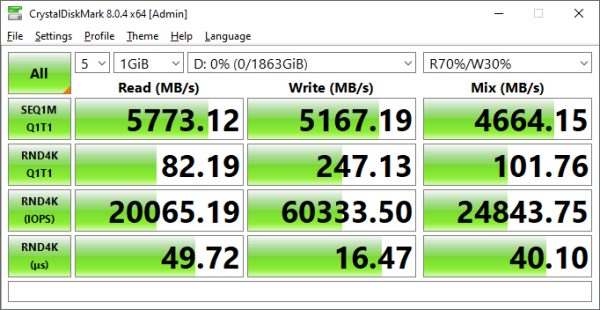
As you'd expect, the Platinum P41 wasn't as fast when tested with the "real world" profile which uses a single thread and a much lower queue depth. Nevertheless, it was still able to read at 5,773 MB/s and write at more than 5,167 MB/s.
HD Tach RW 3.0.4.0:
Next, I used HD Tach to test the Platinum P41's read, write and burst speeds as well as its random access time and CPU usage.
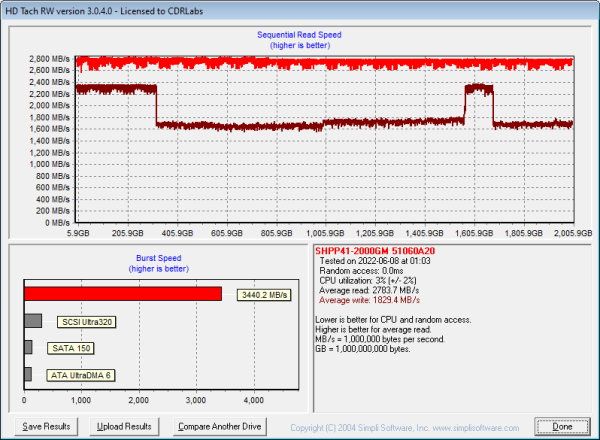
Looking at the screenshot above, you can see that the Platinum P41 had average read and write speeds of 2,783.7 MB/s and 1829.4 MB/s respectively, as well as a burst speed of 3,440.2 MB/s. The screenshot also shows that, like most other TLC-based SSDs, the Platinum P41 uses some sort of SLC caching. The drive starts writing at about 2,350 MB/s and then drops to about 1,700 MB/s when the write operation exceeds the size of the cache.
ATTO Disk Benchmark 4.01:
I also used ATTO Disk Benchmark to test the Platinum P41's sequential read and write speeds. The tests are run using blocks ranging in size from 512B to 64 MB and the total length set to 256MB.
When tested with ATTO, the Platinum P41's read speeds topped out at about 6.88 GB/s and its write speeds at 6.31 GB/s.
AS SSD:
AS SSD is a benchmark designed specifically for solid state drives. The application contains five synthetic tests used to determine the sequential and random read and write performance of a drive.
AS SSD also includes a copy benchmark. This test copies an ISO (two large files), program (many small files) and game (small and large files), returning the speed and duration of each.
HD Tune Pro 5.75:
Next, I ran a series of tests using HD Tune Pro. This hard disk utility measures a drive's performance by testing its sequential read and write speeds as well as its access time, burst rate and CPU usage. For this review, I'm also going to use it to benchmark the Platinum P41's random read and write speeds, random access times and the number of operations per second.
The Platinum P41 performed relatively well when benchmarked with HD Tune. The drive had average read and write speeds of 5612.4 MB/s and 2,688.1 MB/s, respectively.
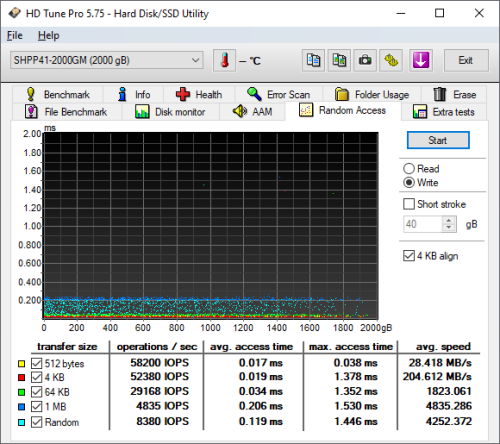 SK hynix Platinum P41 2TB - Random Access Write |
 ADATA XPG GAMMIX S70 Blade 1TB - Random Access Write |
When reading 4KB blocks, the Platinum reached 52,102 IOPS and had an average speed of 203.525 MB/s. The drive was slightly faster when writing, reaching 60,04252.380 IOPS with an average speed of 204.612 MB/s.
Anvil's Storage Utilities:
Anvil's Storage Utilities is another benchmark designed with SSDs in mind. The standard storage benchmark measures a drive's performance by testing its transfer speeds, access times and IOPS.

Iometer:
Lastly, I ran a series of tests using Iometer. This tool can be configured to benchmark a number of things. In this case, I used it to measure the Platinum P41's read and write speeds and the number of operations per second. The tests were run using random bytes and a queue depth of 3.
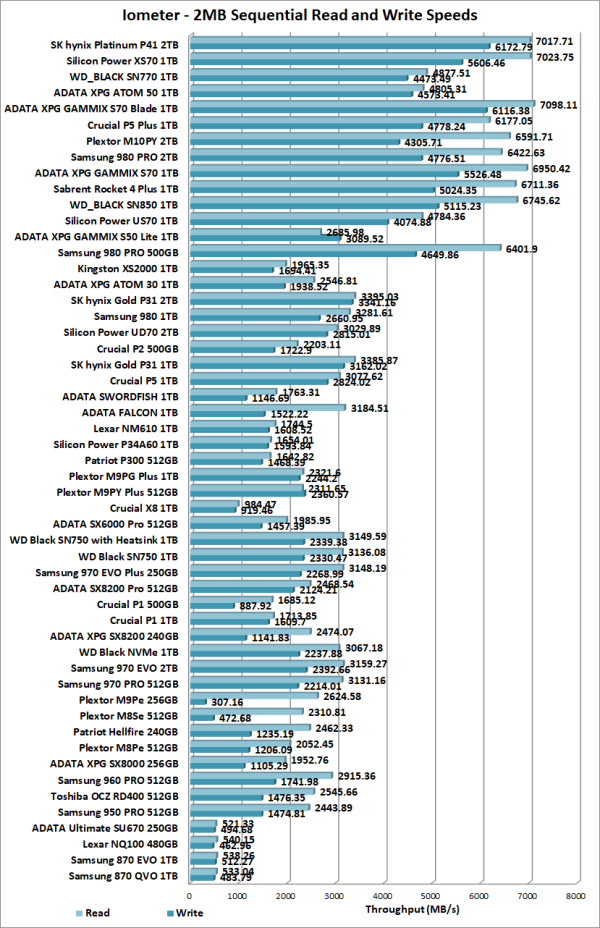
The Platinum P41's performance was very similar to what we saw in our other tests. The drive was able to read at 7017.71 MB/s and write at a blazing 6172.79 MB/s.

The Platinum P41's also performed very well when doing random reads and writes. In our tests, the drive was able to read at 472.18 MB/s and write at 656.09 MB/s.

According to SK hynix, the 2TB Platinum P41 is capable of 1,400k IOPS when reading and 1,300K IOPS when writing 4K blocks with sixteen threads and at a queue depth of 32. With two threads and a queue depth of three, the drive reached 120,877 random read IOPS and 167,958 random write IOPS.
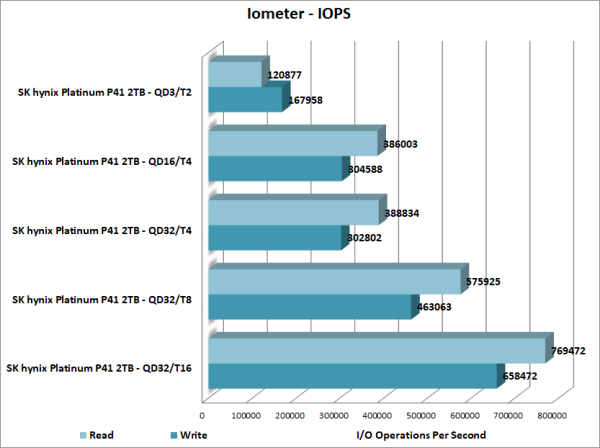
As with most drives, the Platinum P41 performed better with more threads and at higher queue depths. With sixteen threads and the queue depth set to 32, it reached 769,472 random read IOPS and 658,472 random write IOPS.
PCMark 8 - Storage Test:
PCMark 8 is a complete benchmark for Windows. It includes five benchmark tests, each designed around a specific scenario. The storage benchmark measures drive performance using real-world traces recorded from Adobe Creative Suite, Microsoft Office and a selection of popular games.

PCMark 8 also includes a consistency test which measures the performance consistency and degradation tendency of a storage system. The test reports the performance level at the start, the degraded steady-state and the recovered state as well as the number of iterations required to reach the degraded state and the recovered state. For this test, we are focusing on the Adobe Photoshop (Heavy) trace and will look at both the bandwidth and latency of the drive.


The Platinum P41 didn't do as well as some of the other drives in this test. During the degradation and steady phases, its bandwidth dropped below 250 MB/s. The Platinum P41's performance increased somewhat during the recovery phase. However, with it topping out at only 658 MB/s, it still lagged behind the Silicon Power SX70, Crucial P5 Plus and the Samsung 980 Pro.
PCMark 10 - Full System Drive Benchmark:
PCMark 10's Full System Drive Benchmark uses a wide-ranging set of real-world traces from popular applications and common tasks to fully test the performance of the fastest modern drives. This benchmark produces an overall score as a measure of drive performance. Comparing devices is as simple as comparing scores. The tests also measure and report the bandwidth and average access time performance for the drive.
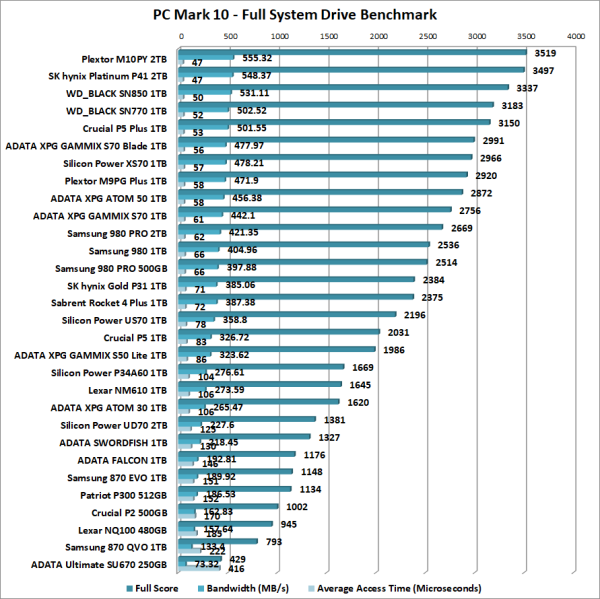
The Platinum P41 did very well in PCMark 10's Full System Drive Benchmark. While not quite as fast as the Plextor M10PY, it performed better than the WD_BLACK SN850, Crucial P5 Plus and ADATA XPG GAMMIX S70 Blade.
TRIM Performance:
While SSD's offer many benefits, there are some downsides to using flash memory. One of the biggest issues people run into is performance degradation. Over time, an SSD will run out of fresh blocks and will have to write over data the file system has marked as deleted. This procedure is very complicated and can slow an SSD's write speeds considerably.
To fix this problem, most manufacturers have added TRIM support to their SSDs. The TRIM command allows an operating system, such as Windows 10, to tell an SSD which data blocks are no longer in use. Using this information, the drive pro-actively erases these blocks and adds them to the free block pool.

To test the Platinum P41's TRIM and garbage collection functions, I first put the drive in a "dirty" state. I used Iometer to fill 80% of the drive and then ran a random write test for 30 minutes. This had little impact on the Platinum P41's read speed. However, its average writing speed dropped to 806.42 MB/s.

SK hynix Platinum P41 - Dirty
To see how well the Platinum P41 could recover, I let the computer sit for about 30 minutes and then reran the test. The drive wasn't able to reach the factory fresh performance shown in our earlier tests. However, its sequential write speed jumped up to 4002.87 MB/s.
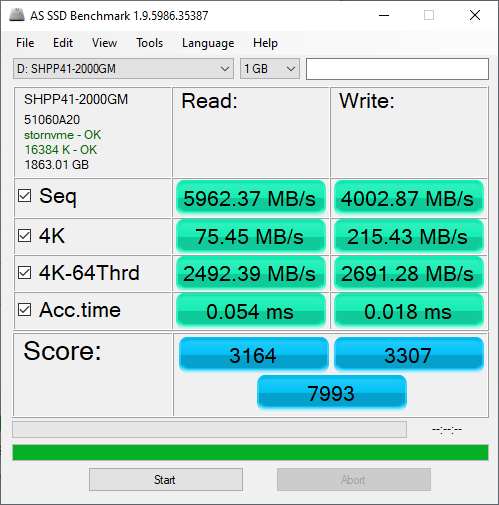
SK hynix Platinum P41 - After TRIM
Lastly, I used Parted Magic to perform a secure erase on the Platinum P41. With the drive wiped clean, it had average read and write speeds of 2951.20 MB/s and 2782.48 MB/s, respectively.
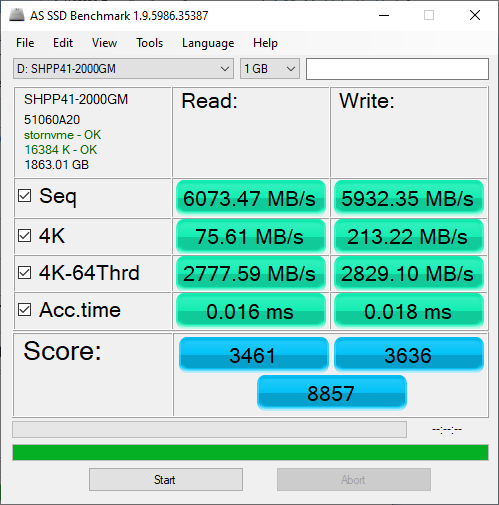
SK hynix Platinum P41 - Secure Erased
Temperature:
While PCIe SSDs like the Platinum P41 offer impressive performance, they also generate a good amount of heat. At idle, the drive's temperature hovered around 37 ºC. When pushed hard, the drive reached temperatures as high as 78 ºC when reading and 77 ºC when writing.

Surprisingly, these temperatures had no impact on the Platinum P41's performance. No matter how hard I pushed it, the drive did not throttle its read or write speeds in any noticeable way.
Final Thoughts:
Despite coming late to the PCIe 4.0 party, SK hynix has really knocked one out of the park with its Platinum P41 SSD. This compact, M.2 form factor drive is powered by SK hynix's own "Aries" controller and is available with up to 2TB of their 176-layer 3D TLC NAND flash. Combine this with the company's HYPERWRITE cache technology and a PCIe Gen4 x4 NVMe 1.4 interface and you have one of the fastest PCIe 4.0 SSDs on the market today. The 2TB version of the Platinum P41 flew through our sequential transfer rate tests, reading at speeds as high as 7,375 MB/s and writing at more than 6,748 MB/s. The drive also did fairly well in our random write tests, producing nearly 168,000 IOPS at low queue depths.
The Platinum P41 is available now in 500GB, 1TB and 2TB capacities and is offered exclusively through Amazon. Prices currently range from $105 up to $260 for the 2TB version reviewed here.

Highs:
- Available in 500GB, 1TB and 2TB capacities
- PCIe 4.0 x4 interface with NVMe protocol
- Equipped with 176-Layer 3D TLC NAND
- Excellent sequential and random read and write performance
- Small M.2 2280 form factor
- Features HYPERWRITE cache technology
- Large DRAM cache
- Supports 256-bit AES hardware-based encryption
- Reasonably priced
- 5 year warranty
Lows:
- Gets hot under heavy workloads
- Limited availability



